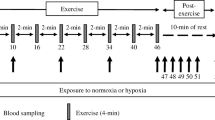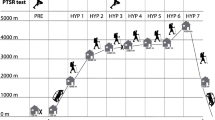Abstract
The assumption that buffering at altitude is deteriorated by bicarbonate (bi) reduction was investigated. Extracellular pH defense against lactic acidosis was estimated from changes (Δ) in lactic acid ([La]), [HCO3 −], pH and PCO2 in plasma, which equilibrates with interstitial fluid. These quantities were measured in earlobe blood during and after incremental bicycle exercise in 10 untrained (UT) and 11 endurance-trained (TR) highlanders (2,600 m). During exercise the capacity of non-bicarbonate buffers (β nbi = −Δ[La] · ΔpH−1 − Δ[HCO3 −] · ΔpH−1) amounted to 40 ± 2 (SEM) and 28 ± 2 mmol l−1 in UT and TR, respectively (P < 0.01). During recovery β nbi decreased to 20 (UT) and 16 (TR) mmol l−1 (P < 0.001) corresponding to values expected from hemoglobin, dissolved protein and phosphate concentrations related to extracellular fluid (ecf). This was accompanied by a larger decrease of base excess after than during exercise for a given Δ[La]. β bi amounted to 37–41 mmol l−1 being lower than at sea level. The large exercise β nbi was mainly caused by increasing concentrations of buffers due to temporary shrinking of ecf. Tr has lower β nbi in spite of an increased Hb mass mainly because of an expanded ecf compared to UT. In highlanders β nbi is higher than in lowlanders because of larger Hb mass and reduced ecf and counteracts the decrease in [HCO3 −]. The amount of bicarbonate is probably reduced by reduction of the ecf at altitude but this is compensated by lower maximal [La] and more effective hyperventilation resulting in attenuated exercise acidosis at exhaustion.







Similar content being viewed by others
References
Bangsbo J, Juel C, Hellsten Y, Saltin B (1997) Dissociation between lactate and proton exchange in muscle during intense exercise in man. J Physiol 504:489–499
Böning D (1974) The “in vivo” and “in vitro” CO2-equilibration curves of blood during acute hypercapnia and hypocapnia. II. Theoretical considerations. Pflügers Arch 350:213–222
Böning D, Trost F, Braumann K-M, Bitter H, Bender K, v. z. Mühlen A, Schweigart U (1980) Altitude acclimatization in skiing lowlanders. Int J Sports Med 1:191–198
Böning D, Maassen N, Steinacker JM, Seifert C, Thomas A, Schmidt W (1999) Carbon dioxide storage and nonbicarbonate buffering in the human body before and after an Himalayan expedition. Eur J Appl Physiol 79:457–466
Böning D, Maassen N, Thomas A, Steinacker JM (2001a) Extracellular pH defense against lactic acid in normoxia and hypoxia before and after a Himalayan expedition. Eur J Appl Physiol 84:78–86
Böning D, Rojas J, Serrato M, Ulloa C, Coy L, Mora M, Gomez J, Hütler M (2001b) Hemoglobin mass and peak oxygen uptake in untrained and trained residents of moderate altitude. Int J Sports Med 22:572–578
Böning D, Klarholz C, Himmelsbach B, Hütler M, Maassen N (2007a) Causes of differences in exercise-induced changes of base excess and blood lactate. Eur J Appl Physiol 99:163–171
Böning D, Klarholz C, Himmelsbach B, Hütler M, Maassen N (2007b) Extracellular bicarbonate and non-bicarbonate buffering against lactic acid during and after exercise. Eur J Appl Physiol 100:457–467
Cerretelli P, Samaja M (2003) Acid–base balance at exercise in normoxia and in chronic hypoxia. Revisiting the “lactate paradox”. Eur J Appl Physiol 90:431–448
Christiansen TF (1981) An algorithm for calculating the concentration of the base excess of blood. In: Siggaard-Andersen O (ed) Proceedings of the IFCC Expert Panel on pH and blood gases held at Herved Hospital 1980. Radiometer A/S, Copenhagen, pp 77–81
Favier R et al (1995) Training in hypoxia vs. training in normoxia in high-altitude natives J Appl Physiol 78:2286–2293
Gregersen MI, Rawson RA (1959) Blood volume. Physiol Rev 39:307–342
Hamadeh MJ, Robitaille L, Boismenu D, Hongsprabhas P, Mamer OA, Hoffer LJ (1999) Human extracellular water volume can be measured using the stable isotope Na34 2SO4. J Nutr 129:722–727
Jain SC, Bardhan J, Swamy YV, Krishna B, Nayar HS (1980) Body fluid compartments in humans during acute high-altitude exposure. Aviat Space Environ Med 51:234–236
Juel C, Lundby C, Sander M, Calbet JA, Hall G (2003) Human skeletal muscle and erythrocyte proteins involved in acid–base homeostasis: adaptations to chronic hypoxia. J Physiol 548:639–648
Juel C, Klarskov C, Nielsen JJ, Krustrup P, Mohr M, Bangsbo J (2004) Effect of high-intensity intermittent training on lactate and H+ release from human skeletal muscle. Am J Physiol Endocrinol Metab 286:E245–E251
Lang W, Zander R (2005) Prediction of dilutional acidosis based on the revised classical dilution concept for bicarbonate. J Appl Physiol 98:62–71
Lundvall J, Mellander S, Westling H, White T (1972) Fluid transfer between blood and tissues during exercise. Acta Physiol Scand 85:258–269
Malapartida M, Moncloa F (1967) Radiosulfate space in humans at high altitude. Proc Soc Exp Biol Med 125:1328–1330
Milledge JS (1992) Salt and water control at altitude. Int J Sports Med 13:S61–S63
Ramirez G, Pineda D, Bittle PA, Rabb H, Rosen R, Vesely D, Sasaki S (1998) Partial renal resistance to arginine vasopressin as an adaptation to high altitude living. Aviat Space Environ Med 69:58–65
Robinson Y, Cristancho E, Böning D (2007) Erythrocyte aspartate aminotransferase as an indirect marker for stimulated erythropoiesis in athletes. Lab Hematol 13:49–55
Rowlands DS (2005) Model for the behaviour of compartmental CO2 stores during incremental exercise. Eur J Appl Physiol 93:555–568
Schmidt W, Rojas J, Böning D, Bernal H, Garcia S, Garcia O (1999) Plasma electrolytes in natives to hypoxia after marathon races at different altitudes. Med Sci Sports Exerc 31:1406–1413
Siggaard-Andersen O (1974) The acid–base status of the blood. Munksgaard, Copenhagen
Wagner PD et al (2001) Pulmonary gas exchange and acid–base state at 5,260 m in high-altitude Bolivians and acclimatized lowlanders. J Appl Physiol 92:1393–1400
Acknowledgments
The investigation was performed during a stay of the first author as visiting professor at the Universidad Nacional de Colombia in Bogotá supported by this institution and the German Academic Exchange Service. The authors thank J. Gomez, B. Himmelsbach, J. Nadol and I. De Velandia for excellent technical assistance and all the subjects for their willing cooperation.
Author information
Authors and Affiliations
Corresponding author
Rights and permissions
About this article
Cite this article
Böning, D., Rojas, J., Serrato, M. et al. Extracellular pH defense against lactic acid in untrained and trained altitude residents. Eur J Appl Physiol 103, 127–137 (2008). https://doi.org/10.1007/s00421-008-0675-0
Accepted:
Published:
Issue Date:
DOI: https://doi.org/10.1007/s00421-008-0675-0




